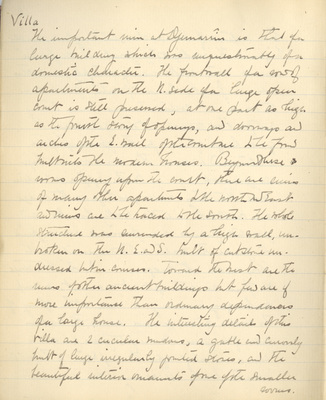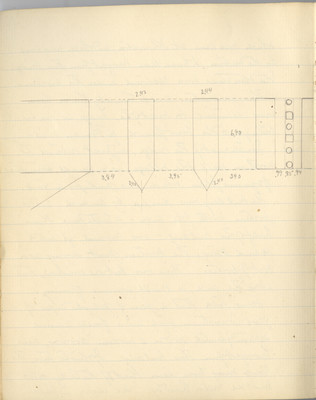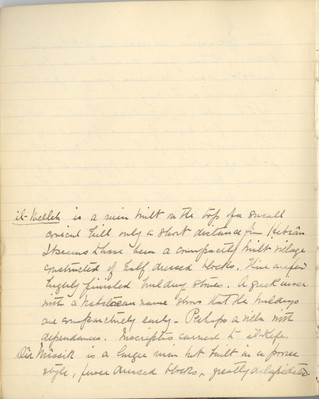Pages
BSY_FB_29-03
Villa
The important ruin at Djemarrîn is that of a large building which was unquestionably of a domestic character. The front wall of a row of apartments on the N. side of a large open court is still preserved, at one part as high as the fourth story of openings, and doorways and arches of the E. wall of the court are to the front built into the modern houses. Beyond these rooms opening upon the court, there are ruins of many other apartments of the north and east and ruins are to be faced to the south. The whole structure was surrounded by a high wall, unbroken on the N.E. and S. built of cut stone undressed but in courses. Toward the west are the ruins of other ancient buildings but few are of more importance than ordinary dependences of a large house. The interesting details of this villa are 2 circular windows, a gable and commonly built of large irregularly pointed stones, and the beautiful interior ornaments of one of the smaller rooms.
BSY_FB_29-03a
3
which was seen at Kharaba, and which was said by the natives, it has been brought from this bridge, the structure was restored under the moslems.
This restoration could hereby have been very extensive for most of the bridge as we see it belongs to the best period of Roman building.
[Sub] Southwest of the bridge, and just outside the Northern wall of the village is a small structure of square plan which was perhaps a tomb. The building was divided by an arch and the portion north of the arch- a little more than half of the building - was carried up into a second story. The southern part seeming as a sort of portico. There was but one window, that above the arch, a small square opening.
I was told that a pair of pilaster caps of good corinthian style and a finely carved section of lintel now in a modern doorway, was brought from this building. If this was true, the tomb may have been that of the lady who built the villa hereby. see inscr. and photo.
BSY_FB_29-04-b
4
From Djemarrîn we rode over to Kharaba following the line of an ancient road for a part of the way. No ruins of any importance were passed on the way.
At Kharaba, a populous Christian village, there are few signs of ruins of great importance The ancient buildings have been completely broken up: but there are no fragments of good carving built into the modern walls as there are in so many of these towns. A large fragment of good wall of rusticated masonry with dappled edges is to be seen in the N.E. part of the village and portions of an ancient house have been utilized in the construction of the house of the Greek priest.
On the return road, from Kharaba to Bosra, we passed over an ancient bridge across the Wadi iz Zîdi the bridge has three arches and was undoubtably built in Roman times, though a cufic inscr. records a [numeral] in the middle ages. The new priests preserve the ancient forms unchanged.
BSY_FB_29-05-a
il- Melleh is a ruin built on the top of a small conical hill only a short distance from Hebrâu It seems to have been a compactly built village constructed of half dressed blocks. These are of highly finished building stones. A greek church with a Nabataean name shows that the buildings are comparatively early. Perhaps a villa with dependances. Inscriptions carved to il-kefr.
Dîr Mîssik is a large ruin but built in a previous style, fewer dressed blocks, greatly delapidated.





